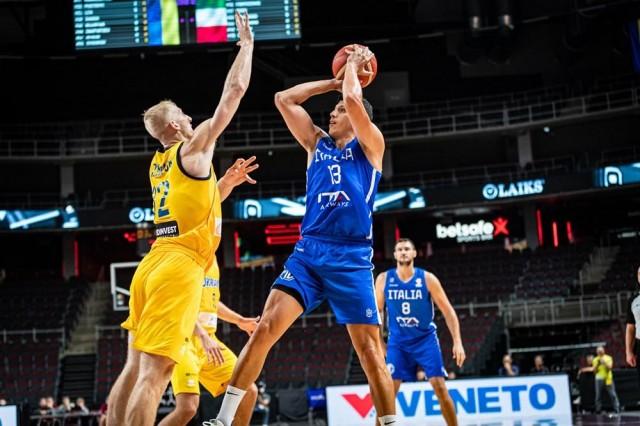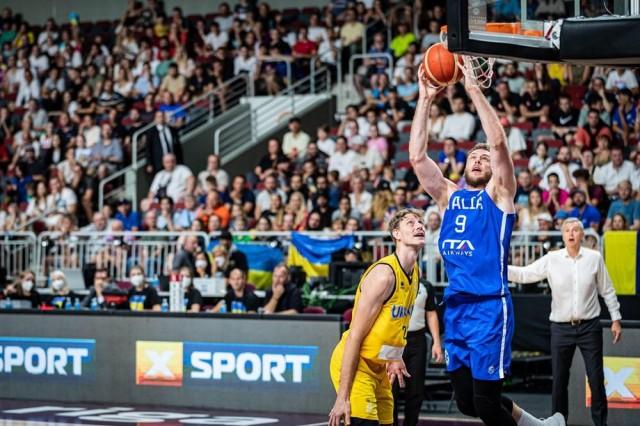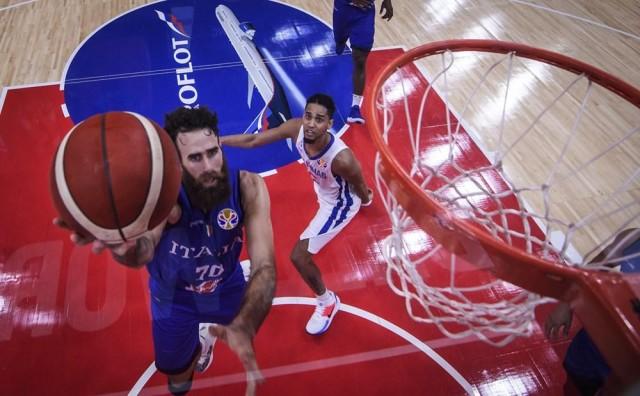FIBA World Cup Preview: A Serbian correspondent breaks down Gilas Pilipinas vs Italy

For Gilas Pilipinas' campaign in the 2023 FIBA World Cup, GMA News Online connected with Milos Jovanovic, a veteran Serbian sportswriter with an interest in Philippine basketball, to help break things down from an outside perspective. Read his previews of the Philippines-Dominican Republic game here and the Philippines-Angola game here.
In modern psychology, the term “deja vu“, which in French means “already seen“, refers to a feeling that someone has lived through a certain situation before once it unravels in front of his eyes. In basketball today, it could also refer to the Gilas Pilipinas coaching staff observing the FIBA World Cup draw back in April at the Smart Araneta Coliseum in Manila. As the millions around the globe watched Luis Scola, LA Tenorio and others draw the Philippines into the group together with Dominican Republic, Angola, and Italy, one could easily imagine the Gilas braintrust of Chot Reyes, Tim Cone and Jong Uichico exchange short glances and utter “Ano ba? Sila na naman?“ (or “What? Them again?“) in disbelief.
Granted, some circumstances changed, but that matters little. It seemed that the stars had aligned in such a way that revanche is on the cards for the hoops-crazy eastern Asian nation, for the luck of the draw brought them very familiar foes to meet at their own home court. The Dominicans, who bested team Pilipinas in Belgrade two years ago, will kick it off in Bulacan, and then it’s time to meet two antagonists from the FIBA World Cup in China from 2019 – the Angolans and the Italians.
For the time being, the bragging rights belong firmly to the other side, as Gilas holds a firm 0-3 in those three recent encounters. In the previous articles, we reminded you how Gilas fared vs. the Dominican Republic and Angola, and profiled those two sides in detail as well. Now, the time is right to talk a bit about Italy, the nominal favourite of the group – and, traditionally, one of the big question marks before every tournament.
Over the last twenty years, you could have made a fortune if you were to accurately predict how Italy would finish at a major tournament – and, consequently, lose it all next time around. Following their late-90s heyday, during which Italians emerged as the most serious challenger to the Yugoslav basketball hegemony, and which saw them win Eurobasket silver in 1997, gold in 1999 and bronze in 2003, coupled with Olympic silver in Athens 2004, it was one wild – and usually disappointing – ride for the Azzuri. They would typically arrive at the tournament in some sort of favourite or dark horse capacity, then perish long before medals come into play. And nobody could quite figure it out how or why.
It would be harsh to say that Italians lacked talent. In the previous decades, star players such as Andrea Bargnani, Marco Bellinelli, Gigi Datome, and Danilo Gallinari would try their best, yet the results never came. Carlo Recalcati, who won the Italian scudetto coaching Varese, Fortitudo Bologna and Siena, tried to gel them into a cohesive battle formation – and failed. So did Ettore Messina, one of Europe’s most celebrated coaches of the modern era, and Simone Pianigiani, whose high-octane approach failed to ignite their fortunes. It was a common joke along basketball journalists that Italy needed four balls in play to stand a chance, as the NBA stars could never quite find their shooting rhythm – nor agree who should be the one chucking it up when it matters most.
The tides started to turn recently somewhat. Old hand Meo Sacchetti, a burly, physical power forward in his playing days who never shied away from contact, shocked Belgrade two years ago by vaulting Azzuri over the favoured home team straight into the Tokyo Olympics, where they placed respectable fifth. Saccheti resigned soon after, and was replaced by Gianmarco Pozzecco, a lively, flamboyant firebrand of a character who not so long ago was the toast of the Italian championship where he flourished as an eccentric point guard for Varese.
Pozzecco continued right where Sacchetti left off. His team snuck into the eight finals of the last year’s Eurobasket, then repeated the Belgrade heroics by unceremoniusly dumping Serbia out of the competition - again. Despite having a loaded squad, complete with NBA MVP Nikola Joki? and Euroleague MVP Vasilije Mici?, Serbians could only watch in despair as the likes of Marco Spissu, Simone Fontecchio, and Achille Polonara poured triple after triple en route to a famous victory. The mere recollection of that event makes me reach for aspirin, so it’s best if we leave this topic closed for now. One year later, the Italians will look to build on their Eurobasket form in a more-less unchanged roster, and look for more scalps to collect en route to another shocking (take this any way you want) finish.

Unlike with the Dominican Republic and Angola, there are very few unknowns on the Italian roster. The core of their squad features heavily in Euroleague and Italian national competition, with Fontecchio the lone NBA export, currently Jordan Clarkson’s teammate with the Utah Jazz. The squad that Pozzecco brings to Manila has been around for a while, knows each other well, and will try and do what they usually do best – wear out opposition with combined defense, while relying heavily on their jump shooting capacities on the other end.
The big names here are undoubtedly Fontecchio and Nicolo Melli. Fontecchio, a 6’7“ guard-forward, saw limited playing time with the Jazz last season, averaging close to fifteen minutes over fifty-two games, with modest averages of 6.3 points on 33% shooting from beyond the arc. But let this not fool you – the Abruzzo native is known for his rapid scoring outbursts, and is not the one you want to leave open at any point in time while he’s on court. His lethal shooting touch – career 40% for 3 in Euroleague – is a feared weapon in Italy’s arsenal.

Thirty-two year old Melli, who alternates between the power forward and center positions, spent some time in the NBA as well, but after splitting two seasons between New Orleans and Dallas he found himself back in the Euroleague with Olimpia Milano. A solid rebounder, who easily can cover both paint positions, Melli has been a key component of Pozzecco’s attacking schemes – he is a good passer out of double teams, but most importantly, his jump shot is consistent enough to be respected by the opposing coaches. Melli’s versatility, as well as his elite hoops IQ, is something that the Gilas staff should take particular note of – he more than held his own against Joki? in 2022, which is definitely something worth noting. Expect Italy to rely a lot on his stretch abilities, with Melli popping out to shoot from midrange and three-point positions.
The veteran Datome, the lone remaining fragment from those Bargnani-led squads, will dance one last time in Manila – the bearded swingman from Montebelluna announced his retirement earlier this year, with the World Cup being his last foray into competitive basketball. He’s not likely to feature heavily, and his defense leaves a lot to be desired at this point of his career, but he still is a capable scorer who will punish you if left unguarded.
Similar can be said for the majority of the Italian supporting cast surrounding Fontecchio and Melli. Whether it’s stretch forward Polonara, experienced two-guard Stefano Tonut or quick-release point Spissu, it is an ill-advised course of action to sag off on any of them – trust me, I know it only too well. Under no circumstance should any of those find open looks, because if they do, they will make you regret those defensive lapses. Alessandro Pajola provides some size and defense on the perimeter, while Nico Mannion misses out this time – the one-time Golden State Warrior played sparingly the last two seasons, following a serious bout with a bacterial infection.
If Italy does have an Achilles heel, it would be their interior presence. Remove Melli, and the list is far from impressive – Paul Biligha is an undersized pivot who helps some on the boards, but he’s not an offensive presence. Veteran Giampaolo Ricci has been around the block and will end some steel to the rotation under the boards, while Luca Severini and Mo Diouf are not expected to carry a big load. The fact that Pozzecco favours a smaller lineup with Melli, Polonara, Fontecchio, Tonut and Spissu comes as no surprise. Also, one can ask as well whether the Azzuri truly have a Plan B in case their shooting deserts them on the day.

Four years ago in Foshan, Datome and Amedeo Della Valle, now also absent, bullied Gilas en route to a blowout victory. But as we established quite a few times already, then was then, and now is now. The Italians will rely on their streaky shooters to wear Filipino defenses, and this recipe bore fruit plenty of times. But should their jumpers fail short in the early phases, the vocal Araneta crowd might start swaying the home side towards something magical.
If you watch NBA regularly, you just know that Clarkson has the ability to take over games, but seldom he’s given that opportunity proper. Here – it won’t be the case. I guarantee you he’ll eat someone up with a monster 40-point performance. And it just could be this enigmatic Italian team.
—JMB, GMA Integrated News




